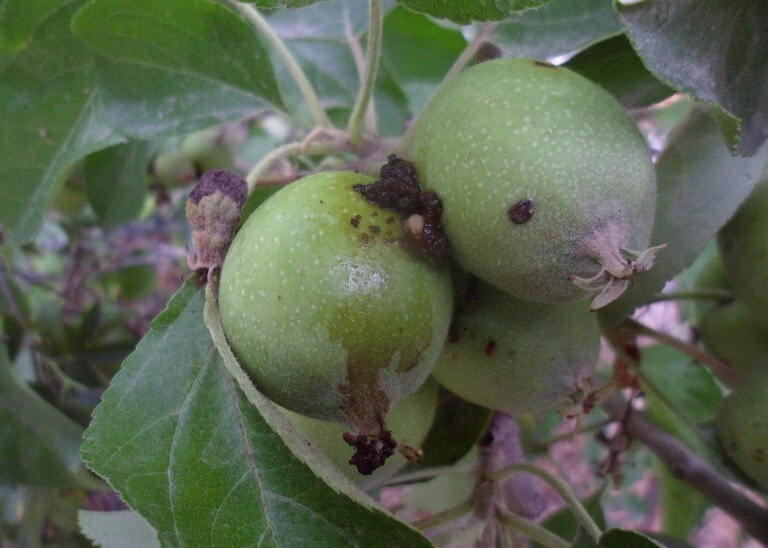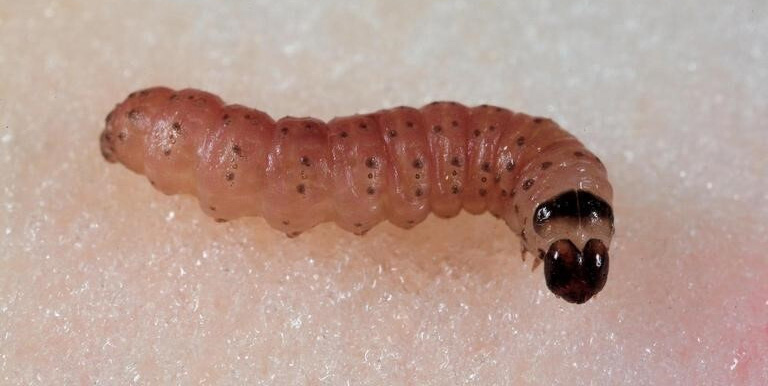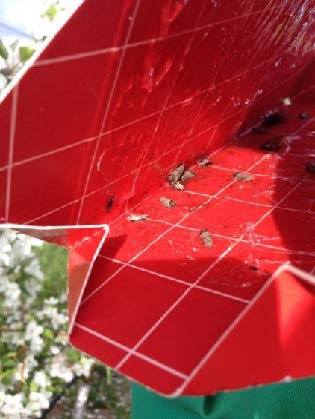Codling Moth Statewide
Scientifiec Name: Cydia pomonella
Hosts:
Apple, pear, crabapple

Figure 1. Codling moth resting on a stem. Photo by Clemson University-USDA Cooperative Extension Slide Series, Bugwood.org
Damage/symptoms:
Caterpillars tunnel inside the fruit and deposit excrement. Holes and egg-laying spots are also evident on the outside of the fruit.

Figure 2. Frass and tunneling damage from the codling moth on the outside of the apples. Photo by M. Louadfel, Bugwood.org
Life cycle:
Codling moths overwinter as pupae in tree bark cracks and soil near trees. As temperatures warm in the spring (approximately above 50ºF), adults emerge, mate, and begin laying eggs near fruit sites on trees. After eggs hatch, larvae feed on leaves, shoots, and later burrow into fruit until they pupate to emerge again as adults. Depending on temperature, there can be up to three generations in Montana per growing season.
Management:
Pick up and dispose of dropped fruit. In small plantings, individual fruits can be protected by pruning each cluster when the apples are about the size of a quarter. This can reduce larval burrowing between touching fruit. Remove small or weakly attached fruits until there are about 1-2 apples. Then the fruit can be wrapped in nylon footlets. Staple the footlet at the top.

Figure 3. Codling moth caterpillar. Photo by G. Csoka, HFIR, Bugwood.org
Trees can also be wrapped in corrugated cardboard, which can help trap larvae that are leaving the apples to find a place to pupate. The cardboard should be removed and destroyed before adults emerge.
Mating disruption is a management technique that involves releasing a male sex attractant into the air to attract males and to disrupt mating. This works optimally with areas of 10 acres or greater.
The timing of chemical controls is critical and coincides with egg laying,

Figure 4. Codling moths trapped May 14, 2018 in Stevensville, MT. Photo credit Zach Miller
which is after flowering and dependent on the number of accumulated degree days (based on weather-see- following page). Never apply a chemical spray during bloom.
The initial emergence of moths is referred to as biofix and involves the capture of male moths in pheromone traps (Fig.4). The timing of chemical controls is based on the degree days accumulated from biofix to target the greatest period of egg hatch. Degree days and percentage of egg hatch are calculated by using the equation below and table, which can be accessed here.
Degree days=
((maximum daily temperature + minimum daily temperature)/2)) -50ºF (base temperature
of codling moth development
Several chemical controls are available. Some of the organic options include the active ingredients spinosad, Bacillus thuringiensis var kurstaki (or Btk) (please note: Btk requires repeated applications with complete coverage), Kaolin clay, horticultural oil, and the codling moth granulovirus (CpGV or Cyd-X). Conventional controls include the active ingredients carbaryl, malathion and permethrin.
Subsequent sprays should be applied according to the label of the chemical chosen. You can use a nearby weather station to calculate degree days and estimate emergence of larvae using the Online Phenology and Degree Day Model provided by USpest.org, which can be accessed here. The Western Agricultural Research Center (WARC) created a new resource specific to home growers which emphasizes non-chemical controls that can be accessed here. WARC also has a page specific for commercial growers that can be accessed here.
By Laurie Kerzicnik, Associate Extension Specialist ll-MSU and Katrina Mendrey, Orchard Program Manager-WARC
Disclaimer: These recommendations are provided only as a guide. It is always the pesticide applicator’s responsibility, by law, to read The authors and Montana State University assume no liability resulting from the use of these recommendations. The Montana State University Extension Service is an ADA/EO/AA/
Veteran’s Preference Employer and Provider of Educational Outreach.

